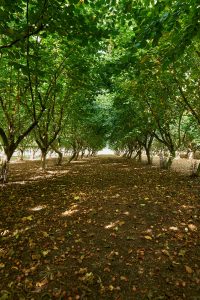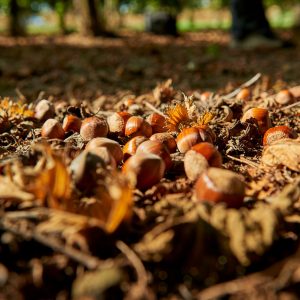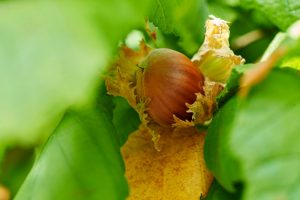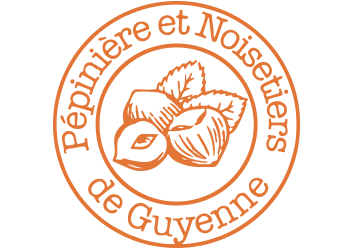Taste and environment take precedence over performance. Over the 900,000 tonnes produced in the world, only around 12,000 are produced in France, and mainly in Lot-et-Garonne. Under these conditions, it is obvious that the quality of the cultivated and harvested hazelnuts is essential to stand out. With 50 years of experience, we are above all nurserymen and hazelnut farmers. This expertise, from orchards to hazelnuts, ready to be used in praline for example, is what gives us our legitimacy. We advise farmers, process hazelnuts and market them to prestigious food industry names, with whom we have preferential relations.
Hazelnuts’ environmental value and quality :
Certifiés Haute Valeur Environnementale 3*
*High Environmental Value Certified
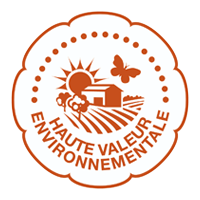
We implement a set of actions aimed at sustaining orchards, managing resources and contributing to biodiversity.
Such as growing grasses in orchards, hedges development for wild animals protection, rainwater collecting in ponds with natural flittering. Our watering methods based on observation, encourage hazelnuts to develop their roots over a large area instead of concentrating them. These methods allow a consumption reduction.
The cultivation conduct
In order to respect environment and orchards, the driving mode is extensive and in no case intensive. Interventions are limited to the maximum. Pruning, tillage, irrigation, each action is the result of observation and reflection, linked to our teams’ expertise. The production is around 2.5 tonnes / hectare while sustaining orchards beyond 40 years. Some hazelnuts are 50 years old, we accept the reduction in their yield. Our hazelnuts’ quality also goes through respectful methods such as harvesting fallen fruits only.
Cutting-edges, Pépinières et Noisetiers de Guyenne is a member of the Association of Hazelnut Producers (APN) and helps to set up experiments. The reflection focuses in particular on the adequacy between terroir and varieties, on reasoned farming methods, on organoleptic improvement of hazelnuts.
Traceability: All the traceability required by agro-food sector’s actors is provided by Pépinières et Noisetiers de Guyenne. From the plant to the hazelnut, adapted procedures guarantee our production quality.
All these methods are shared with our growing partners, to help them in their project
The plantation, a place of cultivation since 1970
The Pépinière et Noisetiers de Guyenne estate has more than 380 hectares of hazelnut trees, part of which will soon be produced from organic farming (in process). A part is already in production and the rest of the orchards will be fully operational by 2030. The presence of trees of different ages contributes to the virtuous management of the park. Orchards are divided between different types of hazelnut trees with careful maintenance for each type. Depending on the variety, everything is done to ensure the quality expected by our customers.
The future : An experimental orchard of 23 hectares under organic management was created in 2019. We plan to diversify into almond, with an eventual production of 50 ha.
Harvesting: as a fundamental step, it marks months of an entire team work. In late summer and early fall, the hazelnut shells slowly turn brown and the involucres, that surround the shell and protect them, dry out and finally shrink. The drying out of the involucre is a sign that harvesting is imminent. When the fruits fall to the ground, it’s time to harvest. The natural cycle is respected. At Pépinières et Noisetiers de Guyenne, the harvest begins around September 15, depending on the varieties’ precocity, and lasts about 1 month. The hazelnuts are then brought to the stabilization station.
About the hazelnut (Corylus avellana): The fruit is generally about 50% to 55% composed of a shell 45% to 50% of an almond. It approximately measures 2 cm. Different studies have shown that a raw hazelnut consists of 22 aromatic compounds. Its raw taste is marked by vegetal, woody but sweet and delicate flavors. When roasted between 130 and 160 degrees, up to 102 volatile compounds can be identified. The roasted hazelnut is characterized by round, woody and sometimes caramelized fragrances. Always crunchy, this is the ideal component for the praline.
Hazelnuts are rich in magnesium, manganese, vitamin E, Vitamin B9, monounsaturated fatty acid. Moreover, the hazelnuts is composed of a source of minerals, vitamins, unsaturated fatty acids and antioxidants
About the hazelnut tree: The hazelnut tree (Corylus avellana L.) belongs to the Betulaceae family. It can stand up to 8 m in height without human intervention. It is a plant suitable for colonizing bare, relatively dry and often sandy places. It helps to hold the soil with its extended and developed roots. If planted at the edge of fields, it helps protect crops from drying winds.
